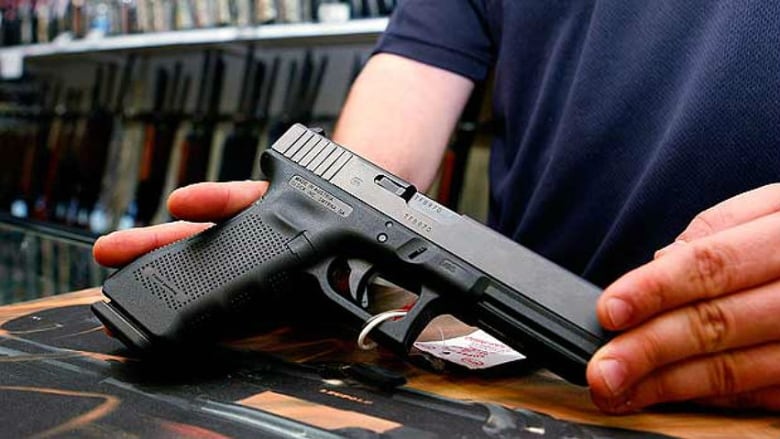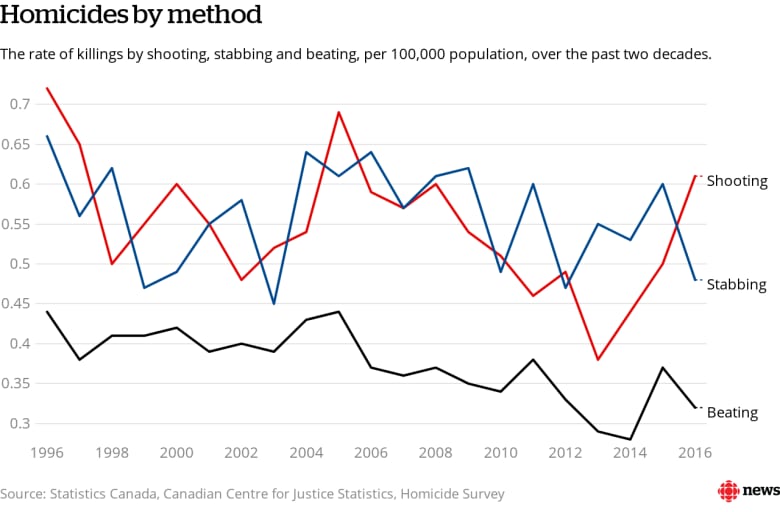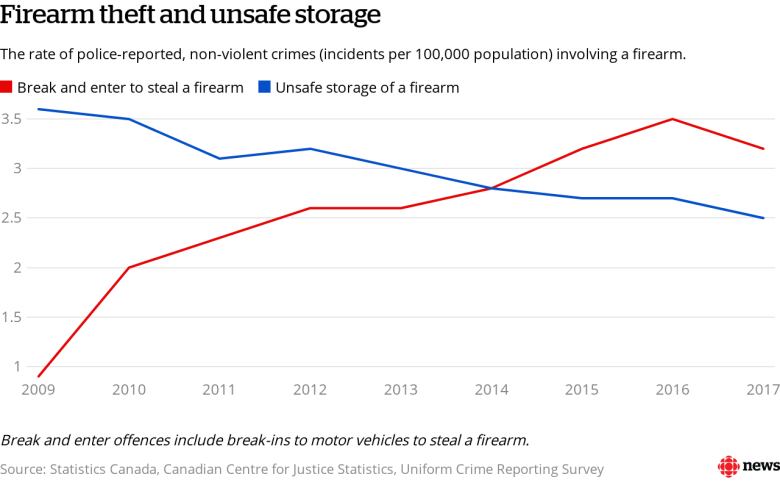Canada gun facts: Here are the latest stats on firearm deaths, injuries and crime
Gun thefts are up nationwide. Gun crime is down in some cities. Most gunshot victims aren't shot by criminals

Guns have been thrust back into the national discourse recently, in the wake of the mass shooting in downtown Toronto and the federal government's plans to explore a potential "full ban" on handguns and assault weapons.
But is gun crime actually on the rise?
And exactly how often are Canadians getting shot and why?
There are various measures of these things and you've likely heard some statistics thrown around, in isolation. But these numbers don't always paint a particularly clear picture. Taken together, however, the data provides a more nuanced perspective.
So, to that end, we've gathered decades' worth of numbers from various sources and compiled them into a handful of charts you can explore below.
Let's start with homicides.
Guns vs. knives
Stabbings and shootings have consistently been the two most common forms of homicide in this country, but it varies from year to year which one leads the way.
Shootings have been on the rise for the past few years, andin 2016 there were more people killed by guns than by knives in Canada.

The use of handguns, specifically, has also been on the rise.
There were 130 homicides committed with a handgun in 2016, Statistics Canada said in a recent report, which was the most in more than a decade.
Handguns accounted for 21 per centof the total homicides that year, and 58 per centof the shooting homicides.
In the United States, by comparison, the report notes there were 7,105 homicides committed with a handgun in 2016, accounting for 47 per centof all homicides south of the border that year.
Of course, not all shootings are fatal, and guns can be used in a variety of criminal ways. So, has gun crime, in general, been rising or falling?
It depends where you look.
Edmonton no longer gun-crime capital
Gun crime tends to ebb and flow in Canada's largest urban centres.
From 2013 to 2016, Edmonton had the highest rate of violent crime involving a firearm.
But gun crime has been on decline in the Alberta capital and it has since been overtaken, slightly, by Calgary and even more so by Toronto on that front.

The rate of violent gun crime (measured in terms of victims per 100,000 population) has been on the rise in Toronto for the past four years.
Vancouver, by contrast, which had the highest rate back in 2012, has seen a steady decline in violent gun crime and, by 2017, it had the lowest rate of five urban centres studied. (Montreal and Quebec City are excluded from this report due to differences in data collection methods.)
The use of firearms in crime raises the question: Where did the gunscome from?
In the past, police have said most crime guns were smuggled into Canada from the United States. But there's some evidence that's been changing, with police in Toronto citing a recent surge in the number of illegal guns sourced from within our national borders.
And the stats do show an increase in the theft of firearms, but there's a bit of catch to those numbers.
Guns stolen in break and enters
While legal gun owners are being charged less frequently with unsafe storage of a firearm, the number of gun-theft charges has grown.
But the specific offence of "breaking and entering to steal firearm" was only added to the Criminal Code of Canada in 2008 and Statistics Canada only began tracking charges under this law in 2009.
As you can see, the rate of these crimes has more than tripled since then, but some degree of ramping up is to be expected, as police services across the country adapt to a new law. And the number of gun thefts edged downward in 2017, with 1,175 incidents last year.

The gun-theft data includes break-ins to both buildings and vehicles.
But police admit there's is no thorough way to account for the origins of all guns that are used in criminal activity.
The RCMP recently told CBCNews that "no such data exists" to provide "a complete, national picture of the sources of crime guns."
It's not just in crime, however, that guns can bring harm to Canadians.
Every year, hundreds of people are accidentally shot, too.
Accidental shootings highest on the Prairies
The rate of accidental shootings both fatal and non-fatal has held relatively steady over the past five years.
An average of 240 Canadianswere hospitalized each year due to the accidental discharge of a firearm.
But the frequency of accidental shootings varies widely, depending on where you live.

People tend to be injured by firearms most often in Saskatchewan, where the rate is triple the national average.
Manitoba and Alberta, respectively, have the next highest rates, while Quebec has the lowest. (The Atlantic provinces are excluded from these calculations because numbers there were too low in some years and suppressed to preserve patient confidentiality.)
In addition to these injuries, accidental shootings also kill about 13 people each year, on average, according to Statistics Canada.
These deaths are dwarfed by suicides, however, which remain the most common way by far for Canadians to die by guns.
Most gun deaths are self-inflicted and intentional
Because they tend to be private matters and not widely reported, suicides can often be overlooked in the discussion of firearms.
But self-inflicted injuries account for three-quarters of gun deaths in this country.

While suicide rates, overall, have held relatively steady over the past decade and a half, the number of suicides by gun have been on the decline.
Self-harm by firearm accounted for 2.2 deaths per 100,000 people in the year 2000, according to Statistics Canada.
By 2016, that was down to 1.6.
In total, suicides accounted for 9,919 of the13,168 gun deaths in Canada from 2000 to 2016.
If you are thinking of suicide or know someone who is, help is available nationwide by calling toll-free 1-833-456-4566, texting 45645 or chatting online withCrisis Services Canada.
Clarifications
- This story has been amended to add more detail about the origin of the "breaking and entering to steal firearm" offence and the data surrounding gun thefts.Aug 31, 2018 9:58 AM MT












_(720p).jpg)


 OFFICIAL HD MUSIC VIDEO.jpg)
.jpg)



























































































